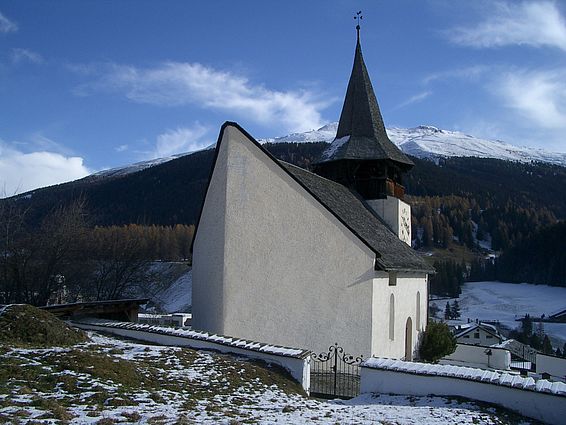Early structural defences
Life in the Swiss Alps would be inconceivable without avalanche protection measures. The earliest evidence of structural defences for individual buildings dates back to the 17th century when, in around 1600, a 4-metre-high and 80-metre-long avalanche deflection wall was built in Leukerbad, and a spaltkeil was constructed to protect a church in Davos (Fig. 1). Likewise in the distant past, buildings were also provided with underground avalanche bunkers, where the residents could seek refuge in case of avalanche danger. The first snow sheds were built in 1805, including on the Simplon Pass. At the time, most avalanche defences consisted of bricks and mortar. In the early 19th century, the first defensive structures were erected in avalanche starting zones – walls and earthen terraces were constructed for the purpose of actually preventing avalanches. In the period to 1938 a network of such defences spanning around 1,000 km was constructed throughout the Swiss Alps (Fig. 2). Johann Coaz, who was one of the pioneers of avalanche protection in Switzerland, already realised around 1910 that the terraces and walls that had been built were too low to afford effective protection (Fig. 3). As long ago as around 1939, the SLF published the first ground-breaking insights into calculating snow pressure, and erected experimental defences on the Dorfberg to investigate the effectiveness of different types of works (Figs. 4 and 5).
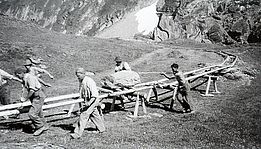
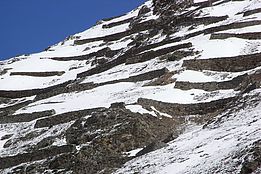
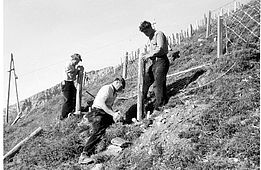
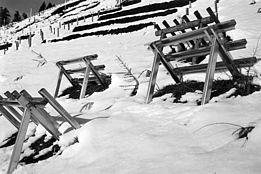
Development of modern retaining structures
A series of major disasters in the winter of 1950/51 prompted a major realignment of avalanche protection activities. Within a short time, walls and terraces were replaced by lean and much more effective structures made of steel, aluminium, wood, wire rope or concrete. In addition, an increase in central government funding triggered a deluge of structural defence projects. In the intervening period, more than 500 km of defensive structures have been installed. In the context of physical avalanche protection in Switzerland, defensive structures play the most significant role. The SLF has been assisting both practitioners and the relevant industrial actors with advice and guidelines ever since the early days. It published initial guidelines on retaining structures in 1955. The current version of the guidelines on defence structures in avalanche starting zones, published in 2007, is based on developments that have taken place over a period of more than 50 years. Steel snow bridges (Fig. 6) and snow nets (Fig. 7) have now emerged as the principal defences. The SLF inspects new types of defensive structures in collaboration with the Federal Office for the Environment (FOEN).
Spatial planning measures
Defensive structures are not the only means of affording protection against avalanches. Sustainable spatial planning based on hazard maps is equally important. As long ago as 1960, the SLF produced one of Switzerland’s first hazard maps, for the community of Wengen (Fig. 8). At the time, such maps were the product of expert assessments on the basis of observed avalanche events, and without any formal calculations. During the avalanche period of 1968, when the region of Davos in particular suffered enormous damage and loss of life, numerous avalanches overflowed the boundaries of the existing danger zones. The SLF responded by issuing guidelines governing the production of hazard maps. More than 80% of local authorities with avalanche-prone regions now have a hazard map.
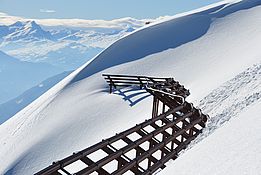
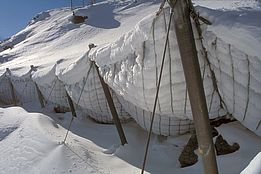
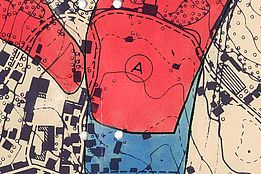
Integrated avalanche protection
Structural and spatial planning measures alone cannot provide adequate protection against avalanches, and structural measures are very costly as well. For this reason, safety authorities in mountain regions nowadays are, to an increasing extent, triggering avalanches artificially in order to protect endangered areas. Such a combined approach to defending against avalanches is known as integrated avalanche protection. It entails coordinating the relevant silvicultural, spatial planning, technical and organisational protection measures in order to efficiently minimise the exposure to avalanche risk. The extreme winter of 1999 demonstrated the effectiveness of integrated avalanche protection. A critical component of this strategy is timely warning of impending natural events. In this context, the Common Natural Hazard Information Platform (GIN) developed by the SLF has established a further benchmark. For the first time, the federal agencies responsible for natural hazards (the FOEN, MeteoSwiss, the SLF and the SED) are now posting their measured and observation data, forecasts, warnings, models and bulletins on a shared internet portal for the benefit of the federal, cantonal and community safety authorities.
